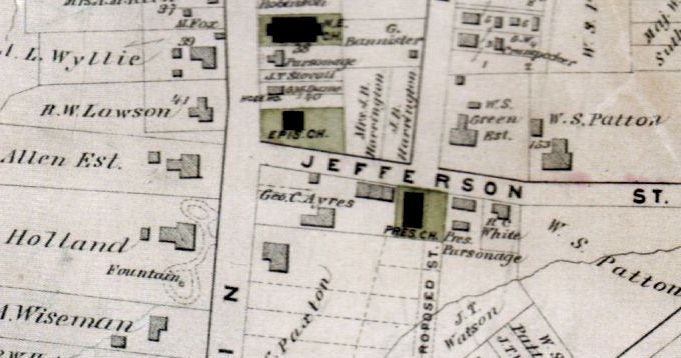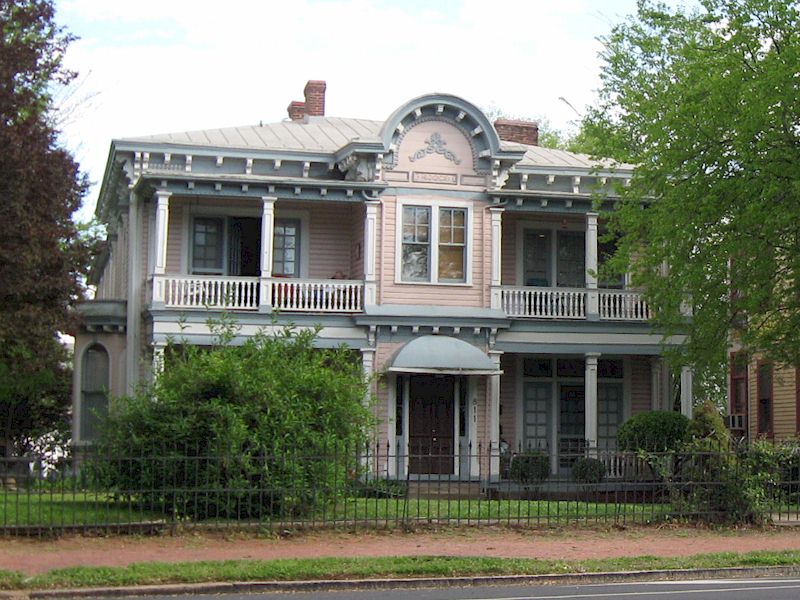Elm Court – 811 Main Street
Reproduced with permission from Victorian Danville – Fifty-Two Landmarks: Their Architecture and History © 1977
Elm Court is a house unique in Danville. Architectural historians say it looks more like a Mississippi River house than a city dwelling. Its history goes back some one hundred and twenty-two years to antebellum days to tell the story of one Jacob Davis, a most lovable old citizen.
Some say to be remembered keep a diary. Jacob Davis kept no diary, but he did keep a notebook. Simply titled Notebook of Jacob Davis, 1855-1877, a black bound typewritten copy can be found in the genealogy section of the Danville Public Library.
This record of births, deaths, real estate transactions, fires and other miscellaneous items relating to Danville during this period, offers interesting tidbits of information. For instance, under the heading of deaths, he wrote, “May 20, 1872. Levi Holbrook, my old preceptor, worn out, 6-1/2 o’clock P.M.” With less comment he entered the death of his son, “Mar. 15, 1855. Jacob Davis, Jr., Rutherfordton, N.C., Typ. fever (24)”. But this story is not about his notebook.
Jacob Davis was from Halifax County. He first appears on the deed books in 1852 when he purchased from Thomas B. Doe one acre, Lot No. 44 on the corner of Main and Jefferson streets. This is the tract of land on which today is situated Elm Court and the Dr. Bruce James House on Main Street and the Greek Orthodox Church and parking lot of the Episcopal Church on Jefferson Avenue.
In 1853, according to the land books, Davis built his home on this corner. Some ten years later the wedding of his daughter, Marie Watkins Davis, occurred here when she was married to George C. Ayres. The marriage ceremony was performed by the Rev. George Dame in February 1863 and oddly enough on April 11, some two months later, Davis conveyed all of Lot No. 44, including his home, to his new son-in-law, George Ayres, for a considerable sum, $20,000. This transaction Davis casually entered in his notebook, “Apl., 1863. J. Davis residence M & Jefferson Sts., to G.C. Ayres, $20,000.00.”
There is speculation as to what happened to this home Jacob Davis sold to his son-in-law. Is it a part of the present house or was it torn down?
Some older Danvillians when interviewed said it had been told to them by their elders that Elm Court started out as a brick cottage facing on Jefferson Avenue (then street) to which “they built around, made larger and added a second floor.” Other persons interviewed contend that George Ayres built the present house outright at a much later date. The deed books and tax records and an examination of the property seem to substantiate the first version – that Jacob Davis’ old house is still here, enclosed by the present structure.
Beer’s map of Danville, 1877, shows the old house, L-shaped, situate on the lot in the same location as the present Elm Court. In 1876 George Ayres had subdivided the lot and built tenements facing on Jefferson Avenue, which have since been demolished. The land books of 1881 verify that George Ayres did indeed do some extensive building of some sort on the Elm Court lot, for the appraised valuation jumped considerably, but no entry was made, as often time was done, that the old house of Jacob Davis was torn down.

To further verify the existence of this older house there is on the side next to Dabney Grant’s residence a portion of the lower wall of Elm Court made of brick while the rest is frame. A later map of 1892 shows the house in the same location as it is today, but of rectangular shape. No doubt George Ayres did add on to the old brick cottage, erect a second story and remodel the house with the Italianate details seen today, the most prominent feature in the design being the central projecting hooded gable decorated with sawn-work scrolls. Sitting on a side of the lot back from the street, its broad front yard emphasizes the rigid character of the building, but it is not likely, had Ayres destroyed the old house, he would have erected the new one on the side of the lot as it is.
Jacob Davis had a second daughter, Sallie King Davis, who married George Ayres’ brother, David, and it was to this daughter that Davis gave, in 1874, a part of a tract situate just opposite the Sutherlin property on Main street which he had purchased from George Townes in 1857. That same year the David Ayres built their home, later the residence of Rorer A. James, Sr., which today, somewhat remodeled, is the home of Mrs. Nora Wiseman.
Davis also, in 1874, sold the remaining portion of that tract across from the Sutherlin mansion to Dr. Lewis Harvie, whose house, also somewhat remodeled, is the home of William H. Haynsworth today.
Davis made an interesting entry in his notebook about this particular tract. “Feb. 20 & 21, 1868. Set out 147 peach trees (and left 25 standing) in Academy lot (172 in all). 21st. set out 16 Locust trees in ditto. Work done by Kiah price, frmn.” Today numerous Locust trees can be seen along the Wiseman lot on Chambers Street, which formerly was known as Academy Street because it either led to or was close by the old Danville Male Academy.
Davis’ two sons-in-law, George and David Ayres, according to Pollock’s Sketchbook of Danville, 1885, operated a tobacco factory on Bridge Street which they had inherited from their father, William, an early settler in the village. George, like his father, served on the Town Council and was Danville’s twenty-fifth mayor. He was among the committee of Forty and foreman of the Grand Jury investigating the Danville Riot.

The occupation of Jacob Davis could never be determined, but his notebook leaves the reader the impression that while he might not have been as successful in business as his sons-in-law, he had a genuine and sympathetic interest in his fellow man and the events surrounding him each day. He died in 1877 and his will reflects the kindness and simplicity of his character. It especially shows the confidence he placed in these sons-in-law, for he named them both Trustees “to take charge of and manage my estate with power from time to time to lay off and sell in small lots any portion of my land.” (All that he owned in the way of real estate at his death were lots on Craghead Street.) In another item he left to George and David certain sums as “remuneration for what they have done for me and family.” Nor did he forget those of lesser means. “I wish,” he wrote, “the title confirmed to my old servants, Miles and Priscila, to one acre of land each.”
It was his desire that his Trustees “erect a plain gravestone at the heads of son, Warren, my wife (Catherine) and myself with a plain inscription stating place and date of birth and death, and my marriage and nothing more.”
Merely his name, date of birth and death, appear on the stone and that of other members of his family in the Ayres plot in Green Hill Cemetery very near the Lee street entrance gate. So far as could be determined no relatives live in Danville today, but in some way, they were-related to the late Winston Edwards, and his sister, Janie.
In 1897 George Ayres suffered financial reverses and placed a deed of trust on Elm Court and the lot on which the Bruce James house was later built. This deed of trust was in favor of Sarah Rhett, who the next year sold the property to satisfy the debt, but again took it in. In 1899 Sarah Rhett sold the Ayres home to Annie Morris Smith, wife of Vincent D. Smith. Mrs. Smith had roomers here and later, in 1918, when she became a widow and married R. B. “Button” Graham, a well-known architect and builder, she sold to T. W. Edmunds. she and Mr. Graham bought the old “Kit” Holland house across the street, and it is said many chandeliers and other fixtures were carried from Elm Court and placed in this home which has now been torn down for the present YMCA [ed: now Union Church].
In 1920 T. W. Edmunds sold to Dr. Bruce James and it was Dr. James who converted the home into four apartments and added the two-level balustraded front porches. And it was he who named it Elm Court after the lovely old elm tree in the front year. This tree was held up by chains for many years, placed there by Dr. James, but finally had to be removed.
After the death of Dr. James in 1930, his widow resided at Elm Court until shortly before her death in 1953, and the property then passed to her three daughters, Barbara J. Rixey, Harrell J. Carrington and Catherine J. Dudley.
James A. and Bernice W. Smith, originally from North Carolina, acquired the property in 1954 shortly after Mr. Smith became president of Dan Valley Mills. The Smiths lived here until 1966 when they moved to Forest Hills. Mr. Smith died in 1966 and the apartments are still owned by his widow.
Some of the original mantels placed there in remodeling by George Ayres can be found in each of the four apartments. The curved stairway in the entrance hall was of this period. The fine cast-iron fence which runs along the front yard on Main was probably placed there by George Ayres. MC

[…] lot on which the house was built was a part of the George C. Ayers property now Elm Court, which was acquired by one Sarah Rhett, an unmarried female […]